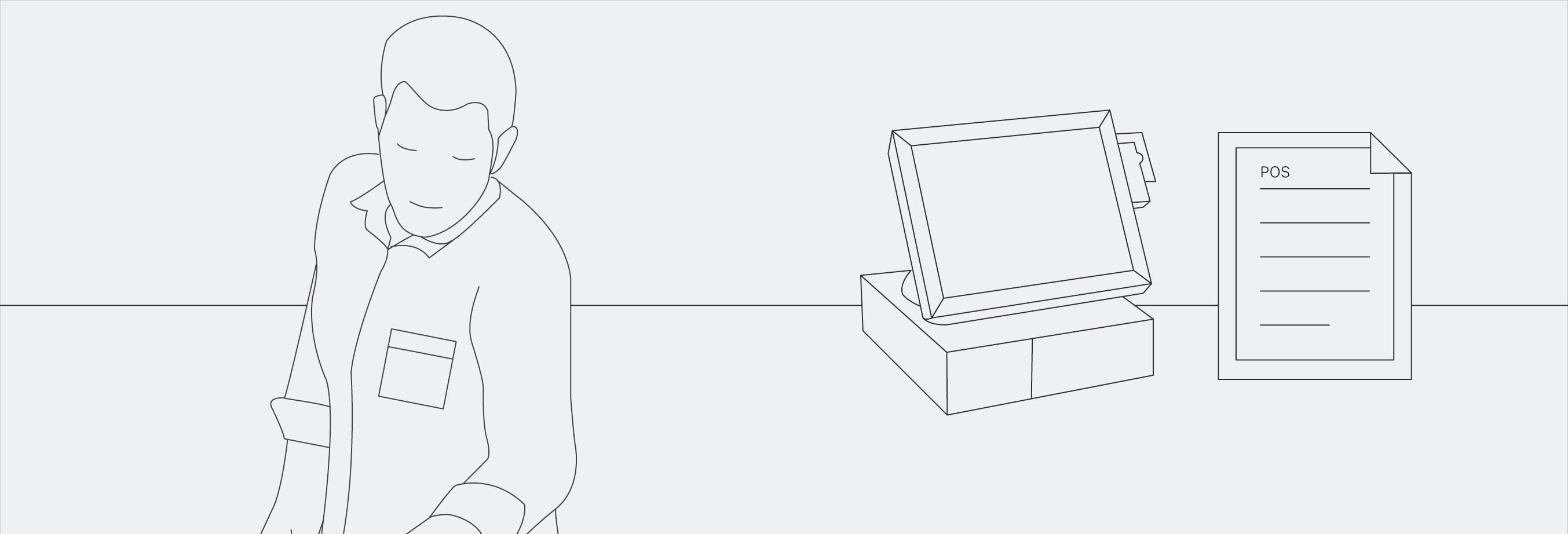

There’s a new wave of great bar and restaurant technology making big changes in the industry. And, as a hospitality professional, these software products exist to help you run a successful business and be better at the job you love. But technology needs updating and correct structuring if it is to be both valuable and profitable, and POS systems are one of the more complex systems to deal with. There are many different ways to structure the Point of Sale (POS) item modifiers in your system. Properly setting up your POS will allow greater flexibility for your staff to upsell and provide a faster ring-in process on the floor.
However, some of these POS configurations can cause major complications when you’re trying to evaluate what you’ve actually poured and the cost of goods sold based on your sales reports.
What does that mean, exactly? Let’s make an Old Fashioned together and see.
Below, we’ve included a few common types of POS structures and the pros and cons of each.
This is the most common type of modifier structure in the industry.
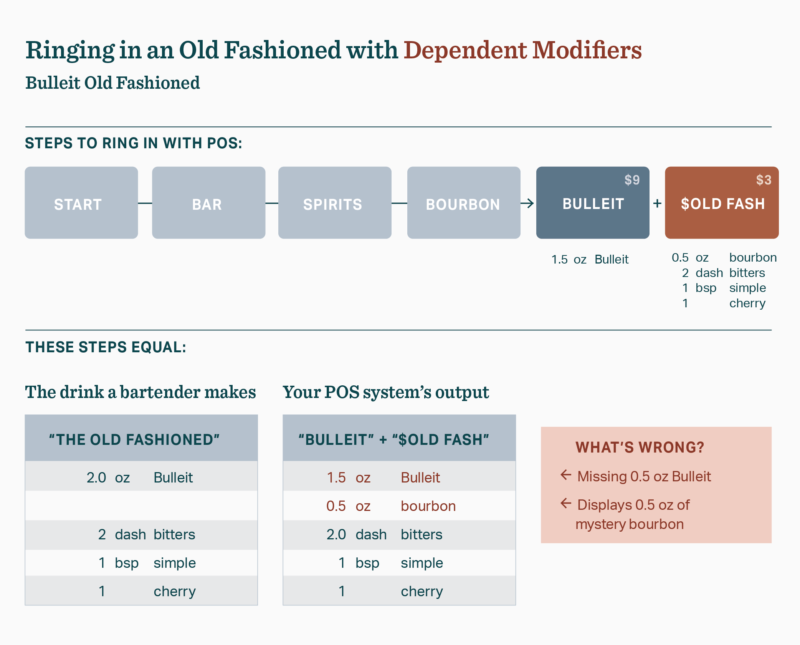
This dependent structure is easy to ring-in on the floor, allows servers to create drinks from any spirit variety, and requires minimal setup, since there are very few buttons to create.
This type of POS modifier structure can work for you without consequences IF you aren’t pouring additional quantity of the first selected liquor.
It’s likely that your ‘rocks’, ‘tall’, ‘up’ or other cocktail modifiers call for extra product than just the standard pour size—and this is where things get messy. In sales reports, your Bulleit sales show up on one line—this represents how many times the ‘Bulleit’ button was hit. The ‘$Old Fash’ button shows up on a separate line, completely separate from the original spirit selection. That means, if you hit the ‘$Old Fash’ button 100 times, across several bourbons, your POS does not connect those extra ounces to the specific product that was actually poured—you cannot effectively track how much product you should be using on each individual item, making it impossible to track key metrics like variance. The data just doesn’t exist.
This can add up quickly. If you pour an extra ounce for every Cosmo, Manhattan, Martini or rocks pour, and you sell 100 of each, that’s 400 ounces of mystery—almost 16 750ml bottles—and there’s no way to tell if they left for legitimate use or walked away. The more you use these types of buttons, the more dangerous they are to your profitability.
This type of modifier structure makes pinpointing loss, over-pouring and pour costing very difficult.
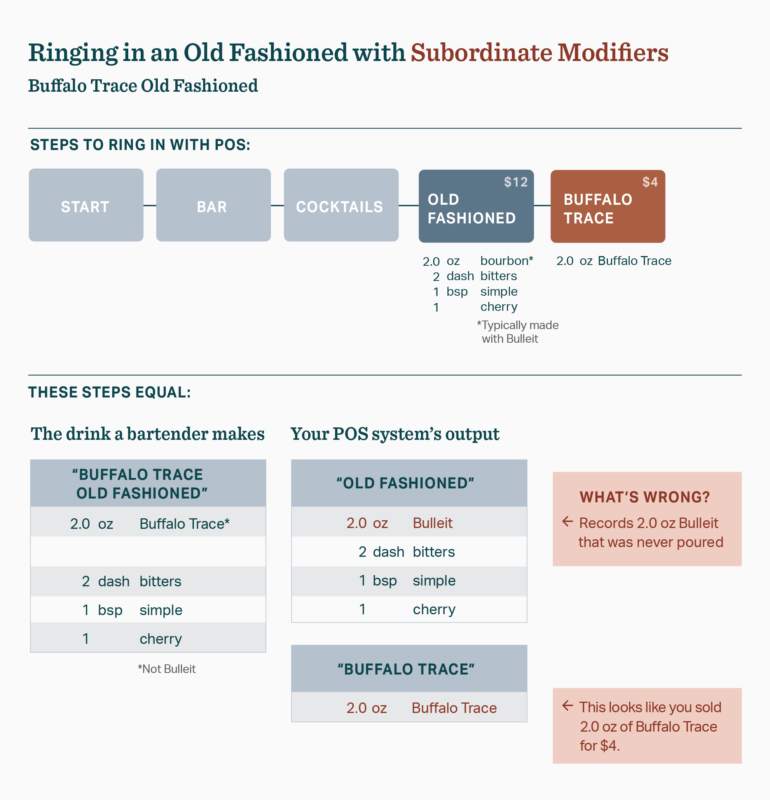
This subordinate structure is easy to ring-in on the floor, allowing servers to upsell to top shelf spirits quickly, and clearly communicates with the bar what should be poured.
This type of structure is far less problematic if the cocktail buttons never appear without a liquor modifier, meaning there is no default spirit and your staff must always select what liquor to pour. If this is the case, you can accurately track pour-for-pour variance. However, your item level cost percentages will be drastically skewed. Take a look below to see how.
This type of modifier structure creates problems when you’re trying to determine which spirits are being poured at what price points. What looks like a simple upsell button actually means a substitution, which artificially inflates your cost percentage.
Here’s an example that better explains what we mean:
When that ‘Old Fashioned’ button appears, your bartender knows to pour 2oz of Bulleit Rye (based on your house recipe). The cost percent of that item is: [cost of Bulleit + bitters + sugar] / [$12]
If the server is upselling to Buffalo Trace for a $4 price difference, that button no longer means 2oz of Bulleit. To your staff, it means NOT 2oz of Bulleit, but instead, 2oz of Buffalo Trace (which doesn’t appear in the data). You have no real way of understanding what you should or should not have poured. Furthermore, your cost percent looks like this:
[cost of Bulleit + bitters + sugar] / [$12]
And separately:
[cost of Buffalo Trace] / [$4]
This doesn’t represent what’s actually happening in terms of cost or in terms of pours. So, you won’t be able to clearly identify what you poured and at what price. Finding variance and making cost decisions will be difficult.
Working on BevSpot’s customer success team, I’ve seen hundreds of sales reports from dozens of different POS systems, at every level of data quality. And you know what? Not one has properly structured modifiers that can give correct variance and pour costing data for these variable drinks. (If anyone has experience with a POS that can handle modifiers better than what we’ve explored above, please let us know in the comments—we’d love to hear about it!)
Until we find that perfect POS, let’s take a look at our recommended method for structuring your current system to get the most accurate info.
If you’re a BevSpot user, this structure will allow you to get the best data from your POS system to use with all of our reporting features. If you’re not a BevSpot user (we think you should be!), this structure will still give you the best view into your data. Let’s check it out:
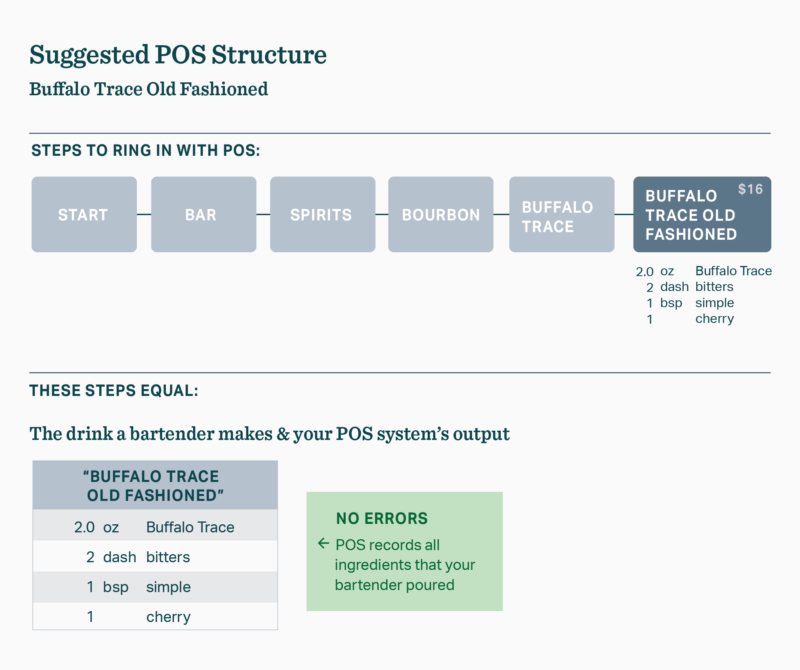
Setting up your POS buttons in decision trees like this, where the full detail of what is being sold is included in the sales item, offers perfect clarity into what’s being poured. You’ll be able to see a line item for the Buffalo Trace you sold at a 2oz pour in Old Fashioneds separately from the Buffalo Trace 1.5oz pour you served neat, and you’ll be able to easily specify the underlying mixers (think: bitters, vermouths and other miscellaneous ingredients) that add to the cost of the drink. This is a seamless way to perfectly track exactly what is happening with every pour you make and every dollar you bring in.
Lots of buttons and set up; staff retraining.
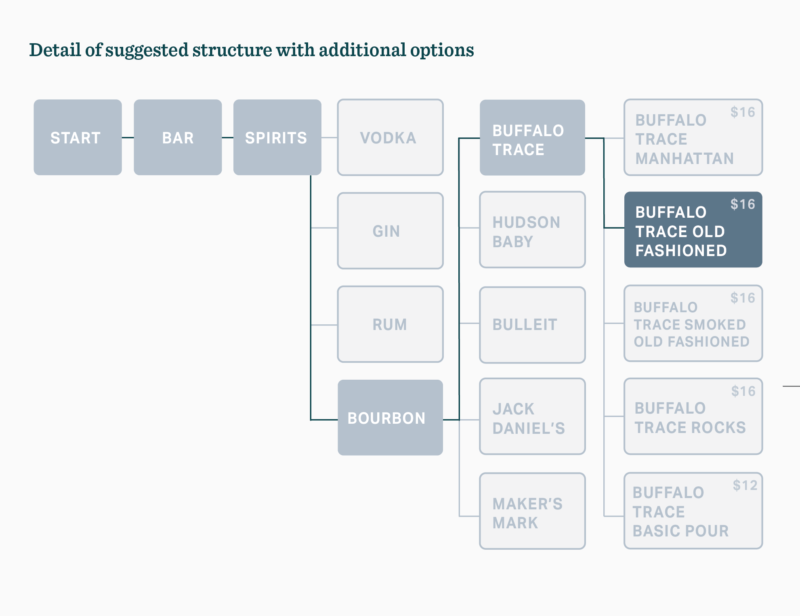
So, what do you do about it?
Your POS system may have one or any combination of these structure types. After evaluating your current setup, if you’re not happy with the information your configuration can provide, don’t fear! This doesn’t mean you need to launch a massive restructure, spending time and money talking to customer service on the help line of your POS system (which we know can be brutal). You can choose to adjust the buttons you use most frequently, or maybe just those buttons that affect your highest volume goods sold.
Evaluate the size of the project:
Maybe you only have a handful of cocktails that are skewing your numbers. Look through the data you’re getting out of your POS today and prioritize what changes you can make to the greatest benefit.
Test on a sample of buttons where you’ve identified a problem:
Testing a restructure of a few buttons will allow you to see a couple things: does the data come through the way want it? Does this change drastically affect your operations on the floor? Changing your entire POS for perfect data won’t do you any good if your servers collapse and your bartenders have no idea what to pour. You want to make sure the changes made give you the information you need to run your business.
Roll out the changes:
After testing, if you’re happy with the results, it’s time to kick things off! You may have the back of house control you need to make this happen on your own, or you may need to loop in your POS company. Give your staff some education on the new process, and prepare to exist in data bliss!
We know POS structures aren’t too high on everyone’s list of favorite tasks behind the bar. That’s why we’re here to help.
If bar management tasks seem daunting, we’ve got you. With BevSpot, you’ll have an expert partner to guide you through every step, and a product that will automatically process all the math afterwards, to boot!
Schedule 15mins to chat with a product specialist
Start a FREE Trial Today! BevSpot offers full product education and account setup for all customers! No card Information needed!
